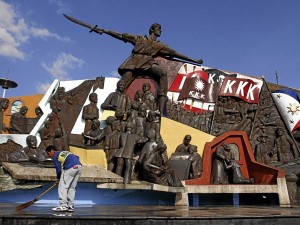
MANILA, Philippines—The revolutionary hero Andres Bonifacio was an excellent poet “and I will challenge anyone who will say he was mediocre,” said National Artist for Literature Virgilio Almario during Friday’s commemoration of the hero’s 149th birth anniversary in Manila.
Friday’s wreath-laying ceremony at Bonifacio Shrine near Manila City Hall also kicked off preparations for the 150th anniversary in 2013. The “Bonifacio at 150” logo was unveiled by the hero’s descendant Emiliano Distrito, Manila Mayor Alfredo Lim, National Commission on Culture and the Arts Chair Felipe de Leon Jr. and National Historical Commission of the Philippines commissioner Ferdinand Llanes.
Almario also launched his book “Ang Pag-Ibig sa Bayan ni Andres Bonifacio” published by the University of Santo Tomas, which deplores the suppression of Bonifacio “as the authentic father of the revolution.”
Almario called for a new image of Bonifacio as he did not wield a bolo but carried a “special revolver.” But whether Bonifacio fired a shot, he said he did not know.
“It’s time not just to honor Bonifacio but to build him a new monument in our shrine of valor. Ang ibig ko pong sabihin ay makawala tayo sa ginawang pagkahon sa imahen ni Bonifacio na masyadong mapangahas, hindi nag-iisip, nangongopya lang, laging may hawak na tabak, hindi po sya humawak ng tabak. Meron syang special na revolver na syang dala-dala nya sa kanyang pakikipaglaban, di ko lang alam kung naiputok,” he said.
Almario also frowned on the widespread representation of Bonifacio as a shabbily-dressed and poor man who sold fans and canes.
“If Bonifacio was shabby, the captain in Cavite, Emilio Aguinaldo, wouldn’t have traveled to Manila to pledge to him,” he said. “And if he was poor, he wouldn’t have been able to join the masonry and La Liga Filipina,” which had Manila’s rich and ilustrados as members.
Almario said Bonifacio sold fans and canes for an additional income but he had other jobs.
He said Bonifacio did not have a formal higher schooling but he knew English and Spanish. “In fact, he wrote a poem in Spanish,” Almario said.
“(Si Bonifacio ay) Isang napakahalagang kawil sa kasaysayan ng ating pantula katulad ni Jose Rizal,” he said.
He said the two differed in writing style because Rizal’s was for the traditional educated and in Spanish, while Bonifacio’s was for the traditional native and in Filipino.
Almario said that unlike the Propaganda Movement, the Katipunan led by Bonifacio wanted independence and not just equal treatment from the Spanish colonizers.
Bonifacio’s poem “Pag-ibig sa Tinubuang Lupa” was sung by Sharon Quintero while mezzo soprano Clarissa Ocampo sang “Mahirap Maging Bayani o Santo” from the opera “San Andres B.” by Almario.
“This day should be the start not just of a call to change the image of the hero of Manila, but to change the image of our city,” Almario said.